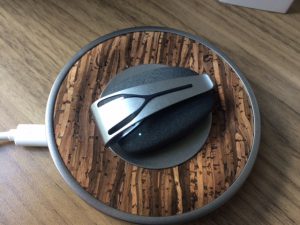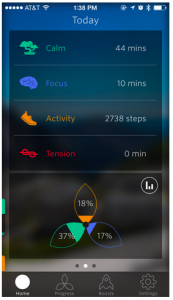Can a piece of wearable technology know when you’re stressed and help you breathe your way to a better state of mind?
That’s the aim of Spire, the stone-like wearable device I’ve been wearing this past summer. Considering the number of wearables on the market that track calories burned, steps taken, or miles traveled, the notion of a product devoted to one’s state of mind makes for an appealing alternative take on wearable technology.

The Spire, in some ways, is like a Fitbit for stress. Spire tracks three sets of data based on your breathing patterns: focus, calm, and activity. It looks and feels like a gray stone with a metal clip fastened to it. You attach the Spire either to front or side of your bra, or to your waistband. The stone-like side of the Spire has to be flat against your body. As mentioned in my previous post, I opted to fasten it to my bra. It is extremely comfortable, and I usually forgot it was there as I went about my day. Other times, it just felt like there was a rock in my bra. It’s also pretty difficult to pull the device off. I didn’t wear it to bed because the Spire is not really conducive to wearing on a giant t-shirt, my preferred sleeping attire.
Spire was created by Jonathan Palley and Neema Moraveji, at the Stanford Calming Technology Lab. According to Palley and Moraveji, the sensor-based Spire interprets the wearer’s state of mind based on the consistency and speed of his or her breathing patterns. So if my breathing slowed, that meant I was calm. If my breathing sped up and was erratic, that indicated I was tense or stressed. If my breathing sped up but was consistent, that meant I was focused.
All of this data is shared with the Spire app when you open it on your iPhone. When you first sign up for the Spire app, it prompts you to set daily goals around calm, focus, and activity. For all of these categories, I set my goals to “Moderate.”

The calendar, or progress tool, shows weekly and monthly calendars that display an interactive, triskelion-like pinwheel that breaks down your daily progress towards your goals. This is where I began to notice a few behavioral trends. For one, I’m calmer than I thought. I fulfilled my calm goals each day I wore the device. Surprisingly, I experienced calm streaks when I was in the car – with the exception of driving on a street riddled with potholes – but I am not as focused as I envision myself to be throughout the workday. For example, last Thursday, I buried myself in focus-intensive work the entire day and hit approximately zero percent of my focus goal. Then on Friday, a relatively light work day, I hit 34 percent of my focus goal. On average, I seemed to hit only 20 percent of my focus goal throughout the entire summer. All this, to me, suggests that perhaps the parameters for measuring a focused state of mind could be inaccurate or faulty.
The Spire app includes brief, audio-guided, meditative breathing exercises called “boosts” that aim to help you adjust your state of mind. In my experience, boosts served as a short-term solution to lessen bouts of stress or increase focus. If I was feeling tense, for example, the Spire suggested a “calm boost.” On a couple occasions, I tried a “focus boost” before diving into my work, but yielded little results as mentioned above.
In truth, the feature I found most useful was the activity tracker (a.k.a. the pedometer feature). Initially, I set the my activity goal to moderate, or 10,000 steps per day. The first two months of wearing the device, I was very conscientious about the level of physical activity I was engaging in and made fulfilling my activity goal a priority in my daily routine. After about two months of wearing Spire, I increased my activity goal to high, or 15,000 steps per day. Around this time, I became more serious about increasing my level of physical activity throughout the day, and I began to ride my bike to work every day. To my dismay, I discovered that Spire cannot capture this kind of activity. Consequently, I very seldom reached my new goal of 15,000 steps. Despite this technical hiccup, for the remainder of the summer, the activity tracker was the only feature that kept me interested in the app.
Overall, I really like the Spire wearable – it’s easy to use. I liked being able to track my activity throughout the day, and the boosts were pretty helpful. The short, meditative exercises helped me step out of stressful parts of my day, that is, in the off chance that I excused myself from my work to slink off into the hallway to do a breathing exercise. I also like that the app enables me to keep tabs on when I was feeling tense. For the most part, the app helped me track my progress or pinpoint why I might have had a stressful day – something I can’t do with activities like meditation or yoga.
On the other hand, I have yet to see any long-term benefits from wearing the Spire device. I want this sleek device that I’m carrying around in my bra like a magical stone to unleash its powers of focus and maximum chill upon me forever and ever. But alas, on really busy days, I still feel myself tensing up and getting overwhelmed when I have too much going on.
If you’ve experienced the Spire for yourself, email hello@fuzzymath.com or tweet us @fuzzymath to share your insights, likes, dislikes, etc.